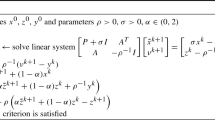Abstract
To ease the programming burden and to make parallel programs more maintainable, computational scientists and engineers currently have the options to use software libraries, templates, and general purpose language extensions to compose their application programs. These existing options, unfortunately, have considerable limitations with compatibility, expressive power and delivered performance. To address these issues, we design a domain specific language, GridFOR, for computational problems defined over regular geometric grids. This language allows the programmer to first implement an algorithm on simple data structures, as commonly illustrated in textbooks or papers. The programmer then specifies transformations to extend the algorithm for complex data structures required by the target applications. We build a compiler to automatically translate a GridFOR program to a parallel Fortran version with Message Passing Interface calls. Several optimization techniques are implemented in our compiler to enhance the program speed.








Similar content being viewed by others
References
Anderson, E., Bai, Z., Dongarra, J., Greenbaum, A., McKenney, A., Du Croz, J., Hammerling, S., Demmel, J., Bischof, C., and Sorensen, D.: LAPACK: A portable linear algebra library for high-performance computers. In: Supercomputing ’90: Proceedings of the 1990 ACM/IEEE Conference on Supercomputing, pp. 2–11 (1990)
Bogey, C., de Cacqueray, N., Bailly, C.: Finite differences for coarse azimuthal discretization and for reduction of effective resolution near origin of cylindrical flow equations. J. Comput. Phys. 230, 1134–1146 (2011)
Brickner, R.G., George, W., Johnsson, S.L., Ruttenberg, A.: A stencil compiler for the connection machine models CM-2/200. In: Proceedings of the Fourth Workshop on Compilers for Parallel Computers (1993)
Christen, M., Schenk, O., and Burkhart, H.: Patus: A code generation and auto-tuning framework for parallel stencil computations. In: Proceedings of IPDPS 2011 (2011)
Cole, M.: Algorithmic Skeletons: Structured Management of Parallel Computation. MIT Press, Cambridge (1991)
DeVito, Z., Joubert, N., Palacios, S.O.F., Medina, M., Barrientos, M., Elsen, E., Ham, F., Aiken, A., Duraisamy, K., Darve, E., Alonso, J., Hanrahan, P.: Liszt: a domain specific language for building portable mesh-based pde solvers. In: Proceedings of 2011 International Conference for High Performance Computing, Networking, Storage and Analysis (2011)
Frigo, M., and Johnson, S.G.: FFTW: An adaptive software architecture for the FFT. In: Proceedings of the 1998 IEEE International Conference on Acoustics, Speech and Signal Processing, volume 3, pp. 1381–1384 (1998)
González-Vélez, H., Leyton, M.: A survey of algorithmic skeleton frameworks: high-level structured parallel programming enablers. Softw. Pract. Exp. 40(12), 1135–1160 (2010)
Grelck, C.: Single Assignment c (sac) High Productivity Meets High Performance. In: Central European Functional Programming School, pp. 207–278. Springer, Berlin (2012)
Grelck, C., and Penczek, F.: Design and implementation of CAOS: an implicitly parallel language for the high-performance simulation of cellular automata. In: Salcido, A. (ed.) Cellular Automata: Simplicity Behind Complexity, pp. 545–566 (2011)
Hasert, M., Klimach, H., and Roller, S.: Caf versus mpi—applicability of coarray fortran to a flow solver. In: Proceedings of the 18th European MPI Users’ Group conference on Recent advances in the message passing interface, EuroMPI’11, pp. 228–236 (2011)
Loveman, D.B.: High performance fortran. Parallel & Distrib. Technol. Syst. & Appl. IEEE 1, 25–42 (1993)
Martha, C.S.: Toward high-fidelity subsonic jet noise prediction using petascale supercomputers. Ph.D. dissertation, School of Aeronautics and Astronautics, Purdue University (2013)
Maruyama, N., Nomura, T., Sato, K., Matsuoka, S.: Physis: An implicitly paralell programming model for stencil computations on large-scale gpu-accelerated supercomputers. In: Proceedings of 2011 International Conference for High Performance Computing, Networking, Storage and Analysis (2011)
Murai, H., and Sato, M.: An efficient implementation of stencil communication for the xcalablemp pgas parallel programming language. In: 7th International Conference on PGAS Programming Models, pp. 142 (2013)
Numrich, R.W., Reid, J.: Co-array fortran for parallel programming. ACM Sigplan Fortran Forum 17(2), 1–31 (1998)
Orchard, D. A., Bolingbroke, M., and Mycroft, A.: Ypnos: Declarative, parallel structured grid programming. In: DAMP’10: Proceedings of the 5th ACM Sigplan workshop on Declarative aspects of multicore programming, pp. 15–24
Parr, T.J., Quong, R.W.: Antlr: a predicated-ll(k) parser generator. Softw. Pract. Exp. 25(7), 789–810 (1995)
Polizzi, E., Sameh, A.H.: A parallel hybrid banded system solver : the spike algorithm. Parallel Comput. 32(2), 177–194 (2006)
Puschel, M., Moura, J.M., Johnson, J.R., Padua, D., Veloso, M.M., Singer, B.W., Xiong, J., Franchetti, F., Gacic, A., Voronenko, Y., et al.: Spiral: code generation for dsp transforms. Proceedings of the IEEE 93(2), pp. 232–275 (2005)
Roth, G., Mellor-Crummey, J., Kennedy, K., and Brickner, R.G.: Compiling stencils in high performance fortran. In: Proceedings of the International Conference on Supercomputing (1997)
Seinstra, F.J., Koelma, D., Bagdanov, A.D.: Finite state machine-based optimization of data parallel regular domain problems applied in low-level image processing. Parallel Distrib. Syst. IEEE Trans. on 15(10), 865–877 (2004)
Situ, Y., Liu, L., Martha, C., Louis, M., Li, Z., Sameh, A.H., Blasidell, G.A., and Lyrintzis, A.S.: Reducing communication overhead in large eddy simulation for jet engine noise. In: Cluster Computing, 2010 IEEE International Conference, pp. 255–264 (2010)
Situ, Y., Wang, Y., and Li, Z.: Automated rapid prototyping of regular grid-based numerical applications using generalized elemental subroutines. In: IEEE 27th International Symposium on Parallel & Distributed Processing (2013)
Tang, Y., Chowdhury, R., Kuszmaul, B., Luk, C., and Leiserson, C.: The pochoir stencil compiler. In: Proceedings of the 23rd ACM symposium on Parallelism in algorithms and architectures, pp. 117–128 (2011)
Unat, D., Cai, X., and Baden, S.B.: Mint: realizing cuda performance in 3d stencil methods with annotated c. In: Proceedings of the International Conference on Supercomputing (2011)
Author information
Authors and Affiliations
Corresponding author
Additional information
This work is sponsored by National Science Foundation via award OCI-0904675.
Rights and permissions
About this article
Cite this article
Wang, Y., Li, Z. GridFOR: A Domain Specific Language for Parallel Grid-Based Applications. Int J Parallel Prog 44, 427–448 (2016). https://doi.org/10.1007/s10766-014-0348-z
Received:
Accepted:
Published:
Issue Date:
DOI: https://doi.org/10.1007/s10766-014-0348-z




